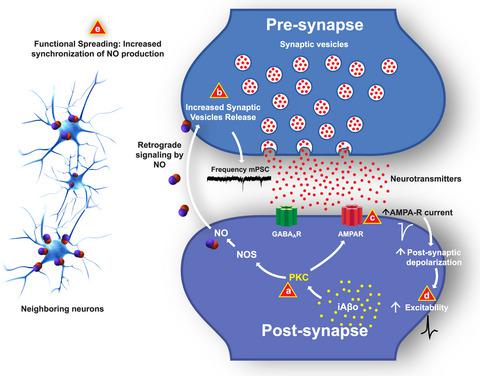当前位置:
X-MOL 学术
›
Aging Cell
›
论文详情
Our official English website, www.x-mol.net, welcomes your feedback! (Note: you will need to create a separate account there.)
Synaptic dysregulation and hyperexcitability induced by intracellular amyloid beta oligomers
Aging Cell ( IF 7.8 ) Pub Date : 2021-08-19 , DOI: 10.1111/acel.13455 Eduardo J Fernandez-Perez 1 , Braulio Muñoz 1 , Denisse A Bascuñan 1 , Christian Peters 1 , Nicolas O Riffo-Lepe 1 , Maria P Espinoza 1 , Peter J Morgan 2 , Caroline Filippi 2 , Romain Bourboulou 2 , Urmi Sengupta 3, 4 , Rakez Kayed 3, 4 , Jérôme Epsztein 2 , Luis G Aguayo 1
Aging Cell ( IF 7.8 ) Pub Date : 2021-08-19 , DOI: 10.1111/acel.13455 Eduardo J Fernandez-Perez 1 , Braulio Muñoz 1 , Denisse A Bascuñan 1 , Christian Peters 1 , Nicolas O Riffo-Lepe 1 , Maria P Espinoza 1 , Peter J Morgan 2 , Caroline Filippi 2 , Romain Bourboulou 2 , Urmi Sengupta 3, 4 , Rakez Kayed 3, 4 , Jérôme Epsztein 2 , Luis G Aguayo 1
Affiliation

|
Intracellular amyloid beta oligomer (iAβo) accumulation and neuronal hyperexcitability are two crucial events at early stages of Alzheimer's disease (AD). However, to date, no mechanism linking iAβo with an increase in neuronal excitability has been reported. Here, the effects of human AD brain-derived (h-iAβo) and synthetic (iAβo) peptides on synaptic currents and action potential firing were investigated in hippocampal neurons. Starting from 500 pM, iAβo rapidly increased the frequency of synaptic currents and higher concentrations potentiated the AMPA receptor-mediated current. Both effects were PKC-dependent. Parallel recordings of synaptic currents and nitric oxide (NO)-associated fluorescence showed that the increased frequency, related to pre-synaptic release, was dependent on a NO-mediated retrograde signaling. Moreover, increased synchronization in NO production was also observed in neurons neighboring those dialyzed with iAβo, indicating that iAβo can increase network excitability at a distance. Current-clamp recordings suggested that iAβo increased neuronal excitability via AMPA-driven synaptic activity without altering membrane intrinsic properties. These results strongly indicate that iAβo causes functional spreading of hyperexcitability through a synaptic-driven mechanism and offers an important neuropathological significance to intracellular species in the initial stages of AD, which include brain hyperexcitability and seizures.
中文翻译:

细胞内β淀粉样蛋白寡聚体诱导的突触失调和过度兴奋
细胞内淀粉样β寡聚体(iAβo)积累和神经元过度兴奋是阿尔茨海默病(AD)早期阶段的两个关键事件。然而,迄今为止,尚未报道 iAβo 与神经元兴奋性增加之间的联系机制。在这里,研究了人类 AD 脑源性 (h-iAβo) 和合成 (iAβo) 肽对海马神经元突触电流和动作电位放电的影响。从 500 pM 开始,iAβo 迅速增加突触电流的频率,并且更高的浓度增强了 AMPA 受体介导的电流。两种效应均依赖于 PKC。突触电流和一氧化氮 (NO) 相关荧光的并行记录表明,与突触前释放相关的频率增加取决于一氧化氮介导的逆行信号传导。此外,在使用 iAβo 透析的邻近神经元中也观察到 NO 产生的同步性增加,这表明 iAβo 可以增加远距离网络的兴奋性。电流钳记录表明,iAβo 通过 AMPA 驱动的突触活动增加神经元兴奋性,而不改变膜的内在特性。这些结果强烈表明,iAβo 通过突触驱动机制引起过度兴奋的功能性传播,并为 AD 初始阶段的细胞内物种(包括大脑过度兴奋和癫痫发作)提供重要的神经病理学意义。
更新日期:2021-09-15
中文翻译:

细胞内β淀粉样蛋白寡聚体诱导的突触失调和过度兴奋
细胞内淀粉样β寡聚体(iAβo)积累和神经元过度兴奋是阿尔茨海默病(AD)早期阶段的两个关键事件。然而,迄今为止,尚未报道 iAβo 与神经元兴奋性增加之间的联系机制。在这里,研究了人类 AD 脑源性 (h-iAβo) 和合成 (iAβo) 肽对海马神经元突触电流和动作电位放电的影响。从 500 pM 开始,iAβo 迅速增加突触电流的频率,并且更高的浓度增强了 AMPA 受体介导的电流。两种效应均依赖于 PKC。突触电流和一氧化氮 (NO) 相关荧光的并行记录表明,与突触前释放相关的频率增加取决于一氧化氮介导的逆行信号传导。此外,在使用 iAβo 透析的邻近神经元中也观察到 NO 产生的同步性增加,这表明 iAβo 可以增加远距离网络的兴奋性。电流钳记录表明,iAβo 通过 AMPA 驱动的突触活动增加神经元兴奋性,而不改变膜的内在特性。这些结果强烈表明,iAβo 通过突触驱动机制引起过度兴奋的功能性传播,并为 AD 初始阶段的细胞内物种(包括大脑过度兴奋和癫痫发作)提供重要的神经病理学意义。

























 京公网安备 11010802027423号
京公网安备 11010802027423号